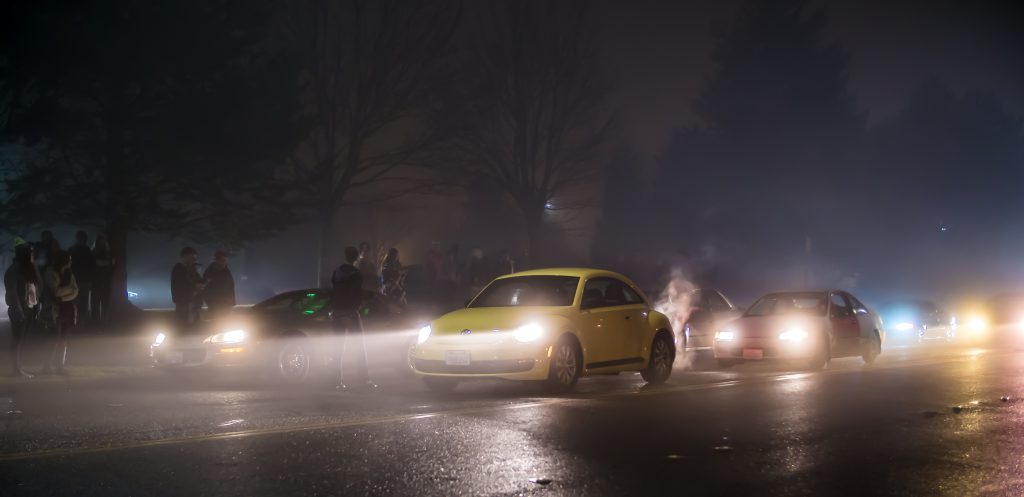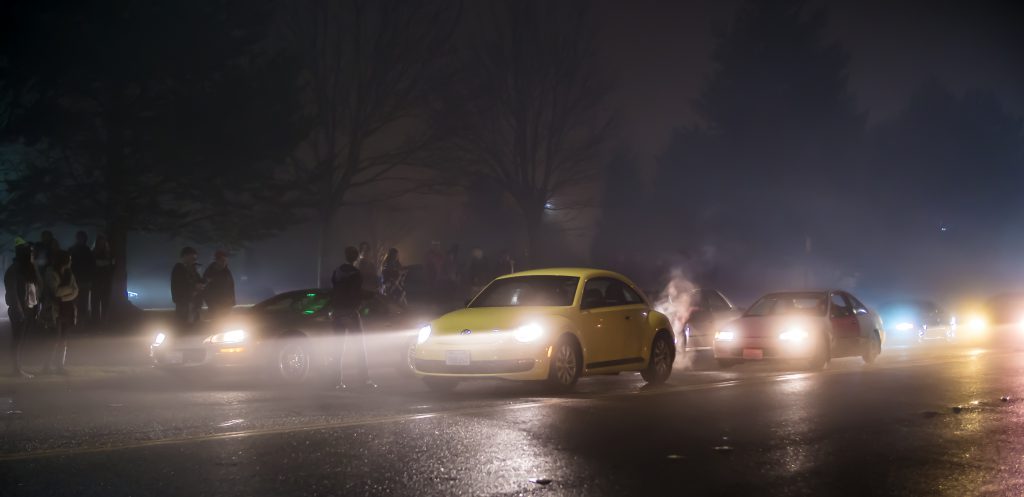By Charles Johnson
Winter 2016 Kaplan Award Winner

Kent is a quiet city by day, but at midnight on weekends, screaming souped-up engines accelerate through the streets, making it the center for illegal street racing in the Pacific Northwest.
Kent has been a hub for street racing for decades. A large warehouse district to the north has smooth, straightaway streets that attract racers, and the warehouses provide parking for onlookers. This is not just a younger crowd; the Kent racing demographic is just as diverse as the cars they bring–teens to seniors, Civics to Lamborghinis.
Austin (last name withheld by request), a frequent participant, recall his first time at the race. “It seemed surreal, it was crazy,” and asks, “how could this possibly be going down every weekend and I don’t know about it?”
Near midnight, racers and observers will meet at a 76 gas station near the Kent-Renton border. Cars pour into the station, and people mingle and check out what’s under the hoods of an impressive variety of cars. Soon, the entire gas station footprint is packed, with cars surrounding pump islands and spilling over to adjacent parking lots.
As racers rumble with impatience, a facilitator—in charge of locating track locations–will climb out of a car and shout out a track name. “Budweiser!” he hollers, code for the street in front of the Budweiser factory, lit brightly with the beer’s red neon sign.
Racers rush to their cars, and the vehicles pour out of the gas station almost at once. Veterans lead, and others fall into fast, centipede-like lines that whip through town towards the location.
At the track, observers park in a deserted warehouse parking lot while racers queue up in one of two lines. A flagger appears, walking between the cars.

The flagger lines up a pair of cars to a mark, then looks at each racer and asks if they’re ready, They answer her with a simple nod, and her arms swing down. Engines scream. It’s a drag race, for a quarter-mile. Once they’re off, the queue lurches forward, and it starts again.
“You have to be really attentive as well, look out for cops, and make sure there’s time between races” Said Phoenix, a flagger and ex-racer. She’s 20, and has partial hearing loss due to years of racing roar.
Kent street races go on, rain or shine. But when it rains, the dynamic is different. On a “drift night” the facilitators select tracks which are more open, to allow participants to pull off fishtailing maneuvers, back-end sliding techniques that require rear wheel-drive cars.
“Drifting is going around a corner and not hitting anything.” Alonzo, a frequent drifter, said with a smile.
Akiba Drift Crusaderz is a notorious crew that stands out on drift nights. Their cars are decked out in puzzle pieces, anime/video game memorabilia with bright LED-lit interiors. They aim to perform in Japan someday day, where drifting originated. Keshawn, a Drift Crusaderz member, believes that drifting and the races are a lifestyle.
“Live in Japan and drift,” he said, “I could work a full time job and be happy as long as I’m doing that.”
Drift nights are a reminder that Kent street races are unsanctioned and unregulated and illegal. Kent Police Department Commander Jarod Kasner says the danger comes from having no safety measures and no control, a mix for injury or death.
“There have been fatalities.” Said Kasner.
KIRO 7 News states that, “…eight people have been killed in street races in South King county over a five-year-span.”
“Sometime our presence deters it, sometimes it does not,” says Kasner.
Police try to bust races from the start, pulling up in the parking lots to flash the blues and reds. Police will vigorously enforce vehicle regulation equipment or speed limits. If police crack the code and show up at a track, racers and observers alike scatter. Penalties for racers and spectsators of races can reach $1,000 and include jail time.
“When cops come to a spot,” said Sean King, another local participant, “we usually have a meet up spot we go back to and then we kind of start it all over.”
After a bust, depending on the time and mood, racers either call it a night or rendezvous again at the 76 or other various locations. Sometimes its a rinse and repeat cycle that can last until 7am.
Kent police have applied some community outreach, with a hope to move racing off the streets and onto the legal tracks.
“There are other avenues that we try to point them to,” Kasner says, “it’s just whether or not that’s what they want to do.”
Racers complain that tracks aren’t open late and that they’re expensive, and there are few such tracks. Kent police has tried to counter by offering free passes to Pacific Raceways, the local motorsports facility; there haven’t been many takers.
The danger doesn’t deter most of the dedicated Kent racers from going. For some, it’s a free car show that happens every weekend night. Others are into the adrenaline rush of street racing. And for many, it’s a lifestyle.
As one regular puts it, “sometimes you have to start from the ground up and the ground starts with the streets.”
